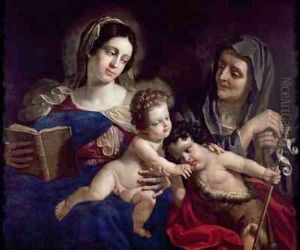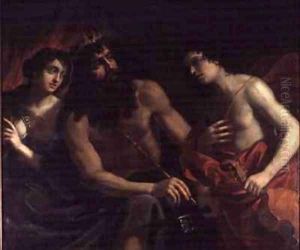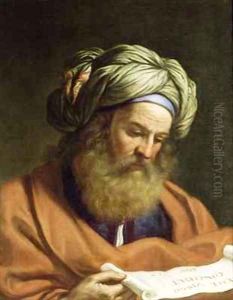Benedetto the Elder Gennari Paintings
Benedetto Gennari the Elder was an Italian painter born in 1563 in Cento, a town in the Emilia-Romagna region of Italy. He is often associated with the Baroque period, a time characterized by its dramatic use of light and color to evoke emotional responses. Gennari's life spanned an interesting period in art history, bridging the late Renaissance and the early Baroque periods, which allowed him to develop a style that incorporated elements from both artistic movements. Despite his contributions, he is less well-known than his descendants, who also became prominent artists, contributing to the Gennari family's artistic legacy.
Gennari's early years were spent in Cento, where he likely received his initial training. The details of his education in art are somewhat obscure, but he is believed to have been influenced by the works of the Carracci family, notably Ludovico Carracci, who was active in Bologna. This influence is evident in Gennari's use of color and composition, which reflect the Carracci's emphasis on naturalism and emotional expressiveness. Throughout his career, Gennari worked on various religious and mythological subjects, which were popular among patrons of the time. His works are characterized by their detailed depiction of figures and use of light to highlight the emotional intensity of the scenes.
Benedetto Gennari the Elder's contribution to the world of art extends beyond his own creations. He was a patriarch of a family of artists who would become significant in their own right, especially in the Baroque period. His sons, Ercole Gennari and Bartolomeo Gennari, and his grandsons, Benedetto Gennari II and Cesare Gennari, continued the artistic tradition, with Benedetto II becoming a notable painter in the court of Charles II of England. This legacy highlights the importance of family workshops in the transmission of artistic skills and styles during the Renaissance and Baroque periods.
Despite his talent and the continuation of his artistic lineage, Benedetto Gennari the Elder's work has not received the same level of attention as that of his descendants or his contemporaries. Nonetheless, his paintings remain important examples of the transition between the Renaissance and Baroque styles in Italy. They encapsulate the evolving tastes and interests of the period, blending the detailed observation of the natural world characteristic of the Renaissance with the emotional intensity and dynamic compositions that would come to define the Baroque.
Gennari died in 1658 in Cento, leaving behind a rich legacy through his family and a body of work that contributes to our understanding of the Italian Baroque period. His paintings, though not as widely recognized today, offer valuable insights into the artistic and cultural shifts of his time, embodying the transition from the refined elegance of the Renaissance to the dramatic expressiveness of the Baroque.


